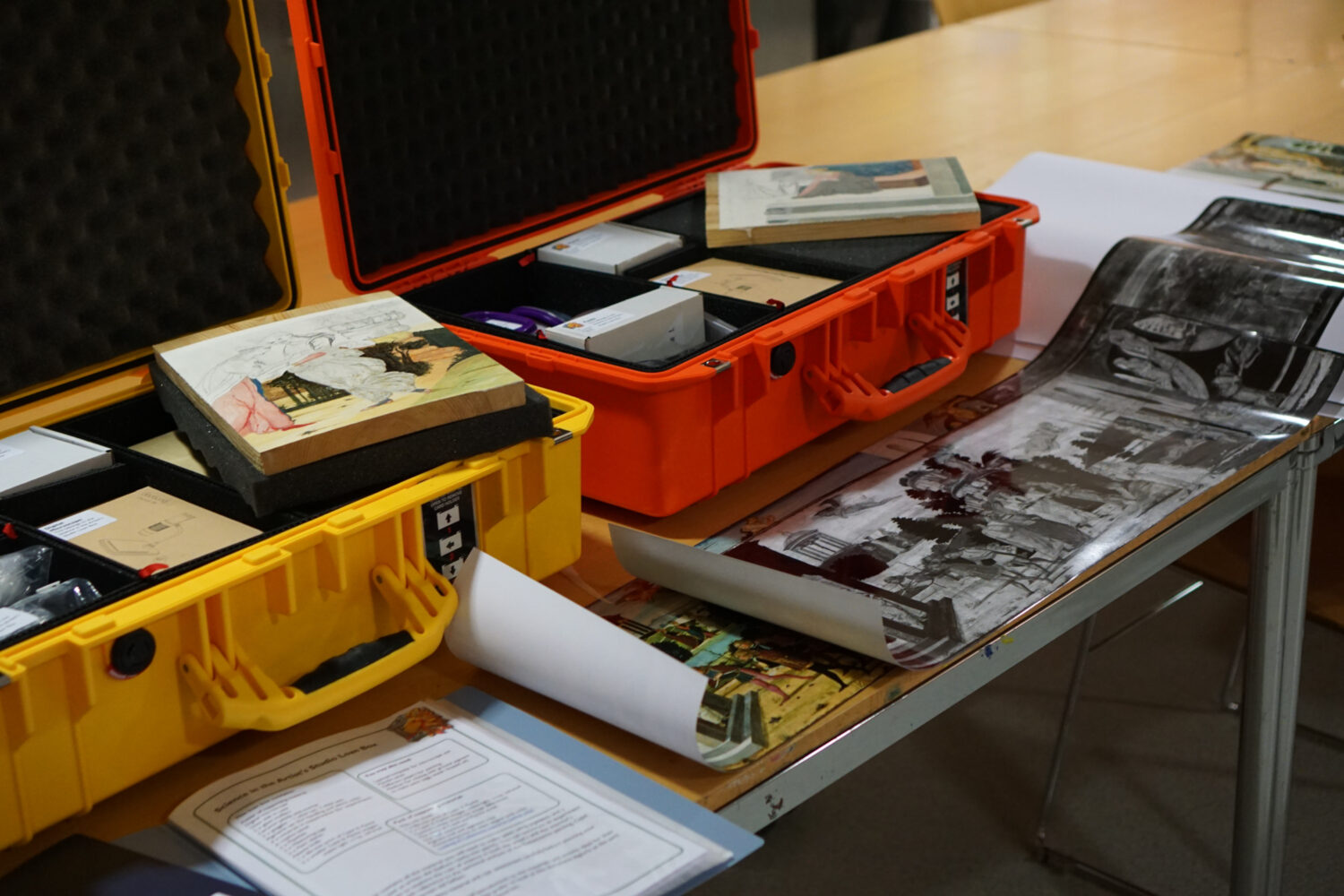Loans boxes: How are paintings made? What are the different ways of looking at paint and paintings? What can we learn by these methods?
This kit contains all the material you will need to make paint using pigments and a medium just as artists did (before ready-mix paint!). You can construct an experiment for students to explore the role of science in both the artist’s and the scientist’s workshop with reference to the technical analysis of the Renaissance painting, Cupid and Psyche by Jacopo del Sellaio. There is material provided with the kit that supports each of the suggested activities below.
Suggested activities
- Reading the narrative in the painting
- Inspecting the large technical analyses images together and spotting key details
- Learn about how Cupid and Psyche was made, using pigments and wooden example panels
- Use the digital microscope to inspect the panels and pigments and match them up
- Explore where the materials and minerals in the loan box came from. How did they get to Italy during the renaissance?
- Make your own paint using the minerals marked for use
- Make a painting with your own paint
- Construct a simple experiment using the variables that change when making your own paint. How can you make it more dense? How can it dry faster?

Each case contains:
Folder of supporting material
Digital microscope
Glass slab in case
3 x glass mullers
Ceramic pestle and mortar
3 x goggles – 1 adult set, 3 child sets
Pigments set (for handling and demo only)
4 x minerals in tupperwares (for experiment)
A replica panel
3 x Pipettes
3 x Measuring jugs
3 x Petri dishes
Palette knife
1 x life-size print of Cupid & Psyche (in a separate poster tube)
3 x smaller Cupid & Psyche images: visible light, x-ray, infrared (in a separate poster tube)
We can provide a foldable flat bed trolley for the transportation of the boxes.
You may also need:
Laptop/computer for microscope use
Paintbrushes
Different papers for painting
Medium for mixing with ground pigment to make paint (egg, water, linseed oil)
Pack of supporting material:
This crib sheet
1 x life-size print of Cupid & Psyche
3 x Cupid & Psyche images: visible light, x-ray, infrared
Teacher’s cheat sheets for image differences
The story of Cupid and Psyche sheet
Our risk assessment
Pigment trail and pigments map
Paint-making how-to video (digital pack only)
KS2
Art
- to improve their mastery of art and design techniques, including drawing, painting and sculpture with a range of materials [for example, pencil, charcoal, paint, clay]
- learn about great artists, architects and designers in history.
Science
- working scientifically, specifically:
- Asking relevant questions, set up practical/comparative enquiries, variables
- Observation, identifying differences, using equipment, recording findings
- Fair tests, identifying differences, using results to draw conclusions
- Reporting on findings from enquiries
These kits are available as a loans box, borrowable for up to one half term period. They are free to borrow and have resources that you can handle and inspect, and also some pigment materials that you can use with your class to make paint.
- suitable for KS2 and KS3
- comes with useful digital and printed resources to provide context and suggest activities
- you must be available for online training on how to use the kit before you can borrow it
- Teachers pick up and bring back the boxes themselves so that they can have a handover with the box and a member of Fitzwilliam Museum staff at both points
- We run through the contents of the box at each stage and museum staff will check at both points for anything that is missing or broken
- We can arrange for parking for short periods, for pick up and drop off
- Some of the pigments in the kit can be used to make paint. Some cannot and are only for observation and handling. These pigments are clearly marked.
- Normal wear and tear is totally understandable! Please report any breakages or missing parts before or on return, that way we can repair and replace parts before the boxes are next loaned.
Cupid and Psyche Look Think Do – Starter activity
Illuminated: more information on how Heritage Scientists use technical analysis to understand art
To request a loan and discuss your needs, email education@fitzmuseum.cam.ac.uk
Access and special educational needs
We are happy to discuss the content of the box and any other details that may be useful in helping your students make the most of their visit.
These boxes are very heavy. We can help you to get the boxes to your car and provide a trolley to move them with, but you may need to arrange for help to get them out and into the classroom. Unfortunately, we do not recommend using public transport to transport the boxes.
Some of the items in this box are fragile and made of glass. If you are interested in the box, we can provide further safety information and our own risk assessment that you can use to inform yours.
We can also print raised line drawings related to the contents with a week or more’s notice.
We find it helpful to receive all feedback, but are especially keen to improve access to our sessions and offer. This is a new offer. Please let us know if we can improve yours, or others’ experience when booking the box.